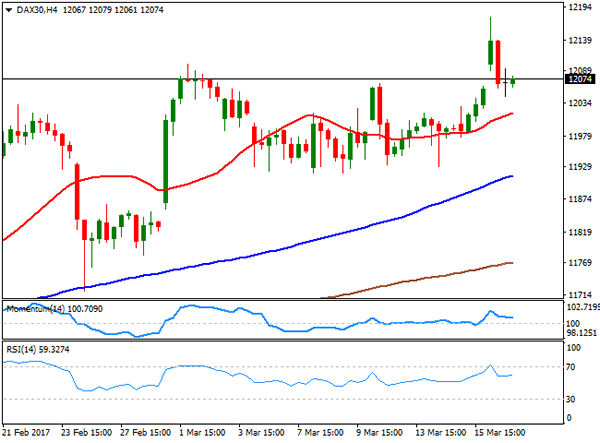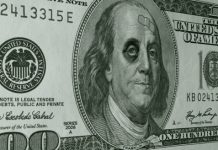EUR/USD
After spending the day in a tight 40 pips range, the EUR/USD pair soared to a fresh 1-month high above 1.0760, following comments from ECB’s Nowotny, governor of the Austrian National Bank and a member of the Governing Council , after he said that rate hikes could be done in a different manner from Fed, and that a "rate increase may be on the way." The greenback remained weak after Wednesday’s Fed’s decision, whilst the common currency find support in the Dutch election’s outcome, as the far-left Party for Freedom came in second with 20 seats, whilst the ruling party won 33 seats, bringing some relief to the EU, diminishing fears that populism is taking over Europe.
In the data front, EU February final inflation figures matched expectations, with inflation confirmed at 2.0% in the month against 1.8% in January. In the US, and for the week ending March 11, initial jobless claims were of 241,000, down 2,000 from the previous week, although above market’s expectations of 240K. Housing starts surged to a fresh 4-month high to a 1.288 million annualized rate, surpassing expectations, although Building permits missed expectations, surging by 1.213 million.
As for the technical outlook, the EUR/USD pair retains a bullish stance as it held well above 1.0700, now breaking also above the previous weekly high. In the 4 hours chart, the 20 SMA heads north after advancing beyond the 100 and 200 SMAs, whilst technical indicators have resumed their advances near overbought territory, favoring additional gains for the upcoming sessions, towards 1.0820, the 50% retracement of the post-US election decline.
Support levels: 1.0745 1.0710 1.0660
Resistance levels: 1.0785 1.0820 1.0860

USD/JPY
The USD/JPY pair established around 113.25 ahead of Friday’s opening, recovering partially from a fresh 2-week low of 112.90 achieved at the beginning of the day. The Bank of Japan has its monetary policy meeting right after US Federal Reserve one, but decided to make no changes to its ongoing stimulus programs. In fact, Governor Kuroda said that an uptick in inflation towards 1% won’t immediately trigger an interest rate hike, indicating that the Central Bank has no plans to modify the monetary status quo, and that the economy still needs massive stimulus to fight deflation. Despite soft, US housing and employment data was enough to prevent the pair from falling further, albeit not enough to revert the negative tone triggered by the Fed. Technically, the 4 hours chart shows that selling interest contained advances around a horizontal 200 SMA, in the 113.50 region, while the 100 SMA stands above it, also lacking directional strength. Indicators in the mentioned chart have bounced modestly from oversold readings, but are far from suggesting a change in the dominant trend. Renewed selling interest below the mentioned daily low should see the pair resuming its decline towards 112.00 a long term Fibonacci support.
Support levels: 112.90 112.50 112.10
Resistance levels: 113.50 114.00 114.50

GBP/USD
The GBP/USD pair soared to a fresh 2-week high of 1.2376, holding nearby at the end of the day. The rally came after the BOE’s monetary policy meeting, as despite the Central Bank left its policy unchanged, there was one dissenter among the MPC member, Christine Forbes. Forbes considered that given that inflation is projected to remain above-target for the next years, while growth is showing signs of slowing, a rake hike was compelling. Additionally, the Minutes of the meeting said that “with inflation rising sharply, and only mixed evidence on slowing activity domestically, some members noted that would take relatively little further upside news on the prospects for activity or inflation for them to consider that a more immediate reduction in policy support might be warranted.” Brexit jitters have been left aside temporarily, although they may return to the market once the Central Banks´ feast euphoria eases. The 4 hours chart shows that the pair has settled above 1.2345, the 50% retracement of the January rally and February’s monthly low, while the price has advanced far above a bullish 20 SMA, and also beyond the 200 SMA for the first time this March. Technical indicators in the mentioned time frame have lost upward momentum and turned fat in overbought territory, not enough to confirm a downward move. Additional advances expose the 1.2425 level, the 38.2% retracement of the same rally.
Support levels: 1.2345 1.2300 1.2260
Resistance levels: 1.2380 1.2425 1.2470

GOLD
Gold prices continued advancing this Thursday, with spot reaching $1,233.62 a troy ounce, to settle at 1,226.60. The sharp advance in the commodity came after the US Federal Reserve indicated that they won’t accelerate the pace of tightening. Gains were contained by increasing optimism after Dutch elections that fueled demand for higher yielding assets. The daily chart for the commodity shows that the price settled below its 20 DMA and a Fibonacci resistance, the 23.6% retracement of the latest daily bullish run at 1,230.10, holding also far below a bearish 200 DMA, currently at 1,250.65. This last, capped February’s rally. In the same chart, technical indicators have extended their recoveries, with the Momentum still below the 100 level and the RSI at 53. In the 4 hours chart, the price is struggling around the 100 and 200 SMAs, both converging around 1,227.00, while technical indicators have turned modestly lower, still holding within overbought territory. Should the price extend beyond the mentioned 1,230.10, the risk turns towards the upside for this Friday.
Support levels: 1,223.15 1,212,90 1,203.30
Resistance levels: 1,230.10 1,242.50 1,250.65

WTI CRUDE
Crude oil prices managed to extend their advances at the beginning of the day, but later retreated, with West Texas Intermediate crude futures settling at $48.70 a barrel after peaking at 49.60 at the beginning of the day. Concerns about rising output in the US weighed on the commodity, despite the latest EIA report showing that stockpiles decreased for the first in the past ten weeks. The daily chart shows that the commodity advanced briefly, but settled below the 200 DMA, currently at 49.10, while technical indicators have turned flat in oversold territory after a modest upward correction, indicating that buying interest remains limited. In the 4 hours chart, the price is standing a few cents above a flat 20 SMA, while technical indicators have pulled back towards their mid-lines, now attempting to bounce, but still within neutral territory.
Support levels: 48.00 47.30 46.65
Resistance levels: 49.10 49.75 50.50

DJIA
US indexes closed mixed, but not far from their daily openings. The Nasdaq Composite advanced less than 1 point, and closed at 5,900.76, while the S&P and the Dow closed in the red, with the first down 3 points to 2,381.38 and the DJIA shedding 15 points or 0.07%, to 20,934.55, as investors continued to digest the latest Fed’s announcement. Within the Dow, most members closed lower, with oil-related equities leading the decline as the commodity failed to extend its latest recovery. El du Pont was the worst performer, closing 1.08% lower, followed by Chevron that shed 0.94%. Financials were among the best performers, with American Express up 0.68% and Goldman Sachs adding 0.58%. The index’s daily chart shows that it held again above its 20 DMA that anyway has partially lost its upward strength, whilst technical indicators erased the positive momentum gained on Wednesday, although hold within positive territory. In the 4 hours chart technical indicators have also lost their bullish strength, now flat above their mid-lines, whilst the 20 and 100 SMAs converge at 20,900, providing an immediate support that if broken, could lead to a deeper correction.
Support levels: 20,900 20,852 20,817
Resistance levels: 20,978 21,015 21,064

FTSE 100
The FTSE 100 closed at a record high of 7,415.95, up by 47 points or 0.64%. The index got a boost from mining-related equities, as a weaker dollar fueled the recovery of base metals. The Footsie reached an all-time high of 7,445, although a strong advance in the Pound weighed on equities mid London session. The top performers were Anglo American closing the day 8.62% higher, Glencore adding 5.01% and Antofagasta surging by 4.65%. Hikma Pharmaceuticals was the worst performer, down by 4.66%. The daily chart shows an increasing upward potential, as the Momentum indicator finally advanced from neutral territory, heading now north at fresh 2-month highs, whilst the RSI indicator also heads sharply higher around 68, and the index holds above all of its moving averages. In the 4 hours chart, technical indicators resumed their advances within positive territory after correcting overbought conditions, whilst the 20 SMA has accelerated its advance below the current level, supporting additional advances as long as Pound’s rally remains contained.
Support levels: 7,399 7,363 7,338
Resistance levels: 7,445 7,480 7,510

DAX
The German DAX added 73 points to settle at 12,083.18, with all of the broad-based European indexes closing with gains this Thursday, fueled by previous Wall Street’s gains, and with optimism surging in the region after the ruling party defeated its populist competitor in the Dutch elections. Within the DAX, Deutsche Lufthansa was the best performer, adding 4.18%, followed by Deutsche Post that gained 1.87%. Heidelberg Cement led decliners, down 1.83%. The DAX closed off an multi-month high of 12,177, level last seen in March 2015. Holding near the mentioned close, the daily chart shows that the benchmark posted a higher high and a higher low daily basis, holding above bullish moving averages, whilst technical indicators head north within positive territory, favoring additional advances ahead. In the 4 hours chart, the index also stands above bullish moving averages, with the 20 SMA now at 12,018, whilst technical indicators have turned flat within positive territory after correcting overbought conditions.
Support levels: 12,059 12,018 11,977
Resistance levels: 12,099 12,140 12,178












